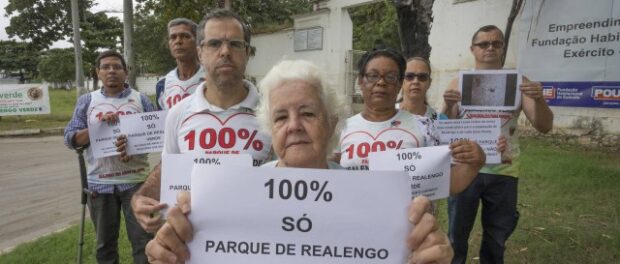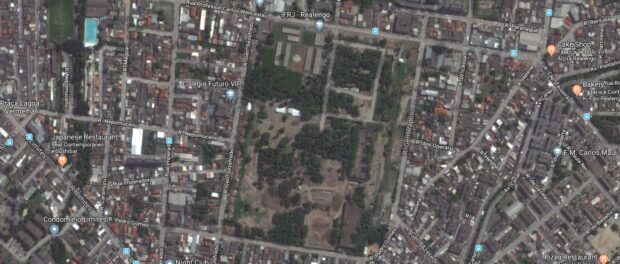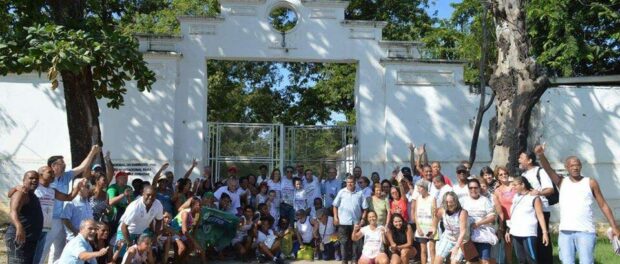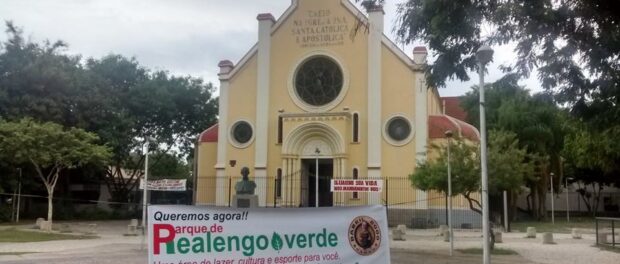
This is our most recent article in a series created in partnership with the Behner Stiefel Center for Brazilian Studies at San Diego State University, to produce articles for the Digital Brazil Project on human rights and socio-environmental justice in the favelas for RioOnWatch.
In August 2020, the residents of Realengo, one of the most populous areas of Rio, received extraordinary news in the midst of the pandemic. The Legislative Assembly of the State of Rio de Janeiro, ALERJ, finally approved the bill that establishes the certification of the area that once belonged to the old Realengo Cartridge Factory—in disuse since 1978—as a historic landmark. In this way, the heritage of this large green space, as well as its cultural, historical and ecological value have been recognized, and its protection ensured.
This is a historical event, since it will be the first ecological park in the West Zone of the city, and located in one of Rio’s hottest neighborhoods, thus guaranteeing investment in the quality of life of residents over speculative interests. The transformation of this area into a public park has been demanded for over a decade, in a constant struggle that has mobilized residents, activists of ecological collectives, and social and religious institutions, united through different movements such as Baía Viva (working mainly with Rio’s polluted Guanabara Bay), SOS Floresta do Camboata and Casa Fluminense.
Leading up to the decision was a public hearing that took place at Castelo Branco University in 2018, promoted by ALERJ, responding to constant pressure from organizations like Realengo 100% Green Park. This meeting was a turning point in the project since it brought together diverse politicians and civil society representatives. Both groups presented their points of view and laid the foundations for a common agreement that would later culminate in a first draft of the bill creating the park, and presented this to the Urban Policy Commission of Rio’s Legislative Assembly.
The conservation of this park, that spans an area of over 142km2—equivalent to 20 Maracanã stadiums—is a victory for the city at large since green spaces are often threatened. The commercial and financial relations between wealthy individuals, private companies and city government, are often the main obstacle to the objectives of ecological, historical and cultural heritage protection.
Over the years, successive municipal governments vetoed conservation projects, while facilitating the settlement of companies in the area, leading to deterioration of the environment. The area of the park, which has more than 3,000 trees of various native species, was used as a reservoir for a waste treatment company. The justification given by the company was the aim of reducing waste derived from the activities of the nearby soil treatment plant. This, however, exacerbated the negative impact on the area, mainly due to the felling and removal of a large number of trees, many of which were centuries old.
The company negotiated directly with the municipal Environment Secretariat to allow it to remove up to 72 trees, compensating this destruction with the planting of 511 native trees in the future. This agreement of environmental compensation, however, is almost never carried out in Rio: numerous environmental violations and crimes have been legitimized in Rio’s natural surroundings and green spaces, with its perpetrators going unpunished.
In the meantime, the loss of trees is deeply felt by residents. The considerable deforestation that has taken place to date has meant the flight of birds and monkeys, including to residents’ homes in search of shelter. Care for the animals became the task of forest rangers of the Pedra Branca State Park—located just below the neighborhood.
Before the bill was passed, the future of this large, abandoned green space did not look promising. For some time, it was in the hands of the Brazilian army’s housing foundation, known as POUPEX (Savings and Loan Association), whose negotiations with the mayor presaged that the space would become their property. The foundation’s objective was the construction of a mega-complex for the personnel of the armed forces. To achieve this objective and in line with the logistics of the previous companies present in the area, POUPEX would resort to the slashing, burning, and demolition of constructions of cultural value, which would consequently bring complete environmental destruction.
Since the area stands out for its lack of infrastructure in regard to sewage treatment and electricity, this would not only have affected the park itself but the neighborhood as a whole, unprepared to face the population increase. “There is no capacity to meet our own demands, let alone those of a complex with more than 500 buildings,” neighbors explained.
The approval of this project represents an enormous triumph, both for nearby residents, and the region’s activists and environmentalists. Little by little, they are beginning to reap the benefits of their tireless work, after a process that lasted longer than expected and that had illusory expectations fed by false promises from government. In 2017, former mayor Marcelo Crivella, after a visit to the neighborhood and an appearance at the Pedro II school, actually announced the implementation of the park project as a “democratic area” and “an accomplishment for our generation.” However, this intention never materialized and was neither approved nor sanctioned.
For the people in the area, the implementation of a public park implies more than leisure: there is a possibility of expanding the Federal Institute of Education in the area. This way, by improving the infrastructure and as a result of past experiences, ecotourism and environmental education projects could be developed within the park itself, which would serve to achieve greater socio-environmental awareness.




